Compare Drones of 2025: Best Models Reviewed
- Nickolas Williams

- May 22
- 16 min read
Updated: May 23
Taking to the Skies: Your 2025 Drone Guide
Choosing the right drone can be difficult with so many options available. This guide simplifies how to compare drones, presenting the top picks for 2025. Whether you need a professional aerial photography platform or an affordable entry-level quadcopter, this list covers models from DJI, Autel, Skydio, Holy Stone, Ryze, and PowerVision. Quickly compare features, pros, and cons of top contenders like the DJI Mavic 3 Pro, DJI Mini 4 Pro, and Autel EVO Lite+, finding the perfect drone for your needs and budget.
1. DJI Mavic 3 Pro
When you're comparing drones, especially at the professional end of the spectrum, the DJI Mavic 3 Pro inevitably enters the conversation. This foldable drone distinguishes itself with its advanced triple-camera system, headlined by a Hasselblad 4/3 CMOS sensor. This, combined with its impressive flight time and robust safety features, makes it a powerful tool for aerial photography, videography, and even commercial applications. If you're looking for top-tier image quality and versatile shooting options, the Mavic 3 Pro should be at the top of your list.
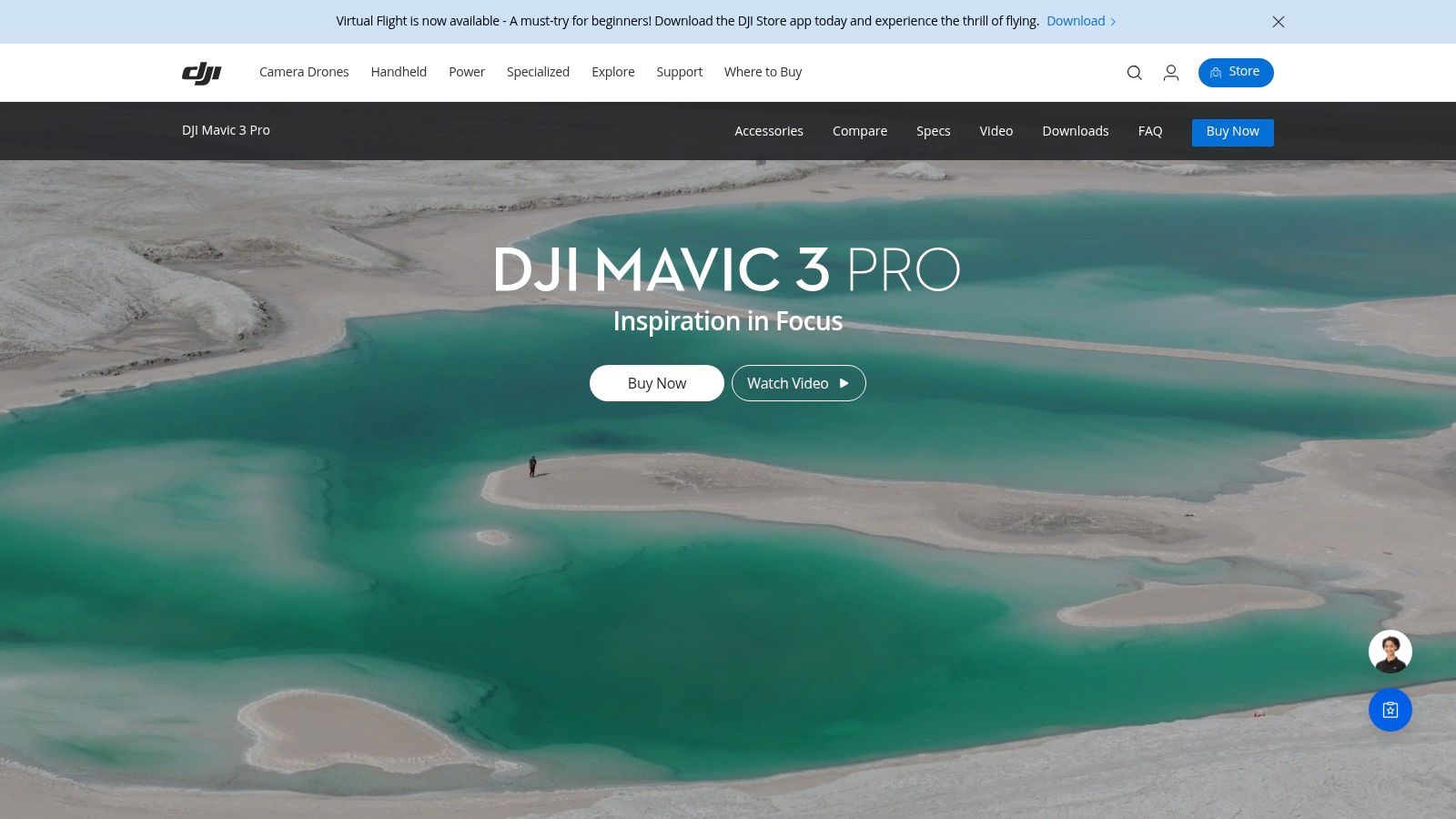
The Mavic 3 Pro's triple-camera setup provides unparalleled flexibility. The Hasselblad camera delivers stunning image quality, while the medium tele camera and the 7x optical zoom tele camera open up creative possibilities for capturing distant subjects and unique perspectives. This makes it ideal for professionals working in fields like filmmaking, real estate photography, and infrastructure inspection. Imagine capturing sweeping landscape shots with the Hasselblad, then seamlessly switching to the telephoto lens to focus on specific details like architectural features or wildlife. Learn more about DJI Mavic 3 Pro to understand the nuances of its camera capabilities.
Beyond its camera system, the Mavic 3 Pro boasts up to 43 minutes of flight time, allowing for extended shooting sessions without frequent battery swaps. Its omnidirectional obstacle sensing significantly enhances safety, making it easier to navigate complex environments and minimizing the risk of collisions. The advanced Return to Home (RTH) functionality provides further peace of mind, automatically returning the drone to its takeoff point in case of signal loss or low battery. These features are invaluable for both beginners and experienced pilots.
While the Mavic 3 Pro excels in many areas, it's important to consider its drawbacks when comparing drones. Its starting price of $1,599 places it firmly in the premium category. The complex feature set, while powerful, can be overwhelming for beginners. Additionally, it's heavier than earlier Mavic models and may require additional licensing for commercial use depending on your region. These factors are crucial to consider when evaluating the Mavic 3 Pro against other options in the market. However, for professionals and serious hobbyists seeking the best possible image quality and advanced features, the DJI Mavic 3 Pro often justifies its premium price tag. You can learn more on the official DJI website.
2. DJI Mini 4 Pro
When you compare drones, the DJI Mini 4 Pro stands out for its impressive blend of portability and performance. Weighing under 249 grams, this ultra-lightweight drone sidesteps registration requirements in many countries, making it a dream for travelers and on-the-go content creators. Don't let its compact size fool you; the Mini 4 Pro boasts professional-grade features typically found in larger, more expensive models. This makes it a compelling option for anyone looking for high-quality aerial footage without the hassle of complex regulations or bulky equipment.

The Mini 4 Pro shines with its 1/1.3-inch CMOS sensor capable of capturing stunning 4K video at 60fps. The 10-bit D-Cinelike color profile provides ample flexibility for post-production grading, allowing users to achieve professional-looking results. Omnidirectional obstacle sensing enhances safety and ease of use, minimizing the risk of collisions, particularly beneficial for beginners. With features like ActiveTrack, MasterShots, and FocusTrack, capturing cinematic footage is incredibly intuitive, even for novice pilots. The advertised 34 minutes of flight time provides a reasonable window for capturing footage, though this will vary depending on wind conditions and usage.
Comparing the Mini 4 Pro to other drones in its class, the combination of portability, camera quality, and intelligent flight modes makes it a strong contender. For instance, while the Autel EVO Nano+ boasts a slightly larger sensor, it lacks the omnidirectional obstacle avoidance found on the Mini 4 Pro. Similarly, while the DJI Mini 3 Pro offers similar portability, the Mini 4 Pro improves upon it with enhanced obstacle avoidance and a longer flight time.
Key Features and Benefits:
Sub-249g Weight: Travel hassle-free without registration worries in many regions. This is a crucial advantage for those who frequently travel with their drones.
High-Quality Camera: Capture professional-grade 4K/60fps video with a 1/1.3-inch CMOS sensor and 10-bit D-Cinelike color profile.
Omnidirectional Obstacle Sensing: Enjoy enhanced safety and peace of mind during flight. This feature minimizes the risk of crashes, especially for beginners.
Intelligent Flight Modes: Utilize ActiveTrack, MasterShots, and FocusTrack for effortless cinematic footage. These features simplify complex camera movements, making professional-level shots accessible to everyone.
Pros:
Extremely portable and travel-friendly
High-quality camera for its size class
No registration required in many countries
Excellent wind resistance for its weight
Cons:
Limited battery life compared to larger models (34 minutes)
Smaller sensor than professional models
More susceptible to strong winds than heavier drones
Higher price point than previous Mini models (starting at $759)
Implementation/Setup Tips:
Ensure you have the latest version of the DJI Fly app installed on your compatible smartphone or tablet.
Familiarize yourself with the drone's controls and safety features before your first flight.
Calibrate the compass and IMU regularly for optimal performance.
Consider purchasing extra batteries to extend your flight time.
If you're comparing drones and prioritize portability without compromising on image quality and intelligent features, the DJI Mini 4 Pro (https://www.dji.com/mini-4-pro) deserves serious consideration. It's an excellent choice for travelers, vloggers, and anyone looking for a compact yet powerful aerial photography platform.
3. Autel Robotics EVO Lite+
When you compare drones, the Autel Robotics EVO Lite+ often emerges as a compelling alternative to DJI's dominant market share. This premium drone packs impressive features that cater to both enthusiasts and professionals, making it worthy of consideration for serious aerial photography and videography. Learn more about Autel Robotics EVO Lite+
The EVO Lite+ boasts a 1-inch CMOS sensor capable of capturing stunning 6K video, providing incredibly detailed footage. This, combined with its adjustable aperture (f/2.8-f/11), allows for greater creative control over depth of field and excels in low-light conditions, a feature often lacking in other drones. This makes it ideal for capturing breathtaking sunsets, dimly lit cityscapes, or even night flights. Whether you’re a professional filmmaker, a real estate photographer needing high-resolution images, or a hobbyist seeking cinematic footage, the EVO Lite+ delivers.
Beyond image quality, the EVO Lite+ offers practical advantages for various applications. Its 40-minute flight time provides ample time to capture the perfect shot or explore a larger area, outperforming many competitors in its class. The 12km video transmission range provides a stable and reliable connection for long-distance flights, opening up possibilities for expansive aerial surveys, infrastructure inspections, or simply exploring vast landscapes. The advanced autonomous flight modes further simplify complex shots, enabling dynamic tracking, cinematic orbits, and effortless point-of-interest circling.
For those comparing drones based on ease of use and setup, the EVO Lite+ is relatively straightforward. While its mobile app may not be as polished as DJI's, it provides all the necessary controls and features for flight planning, camera settings, and autonomous flight modes. The drone itself is ready to fly out of the box with minimal setup required.
A key advantage for some users is the absence of geofencing restrictions, a feature often found in DJI drones that limits flight in certain areas. This gives EVO Lite+ users more freedom and flexibility in choosing their flight locations.
Pros:
Superior low-light performance thanks to the adjustable aperture and large sensor.
Long 40-minute flight time allows for extended shooting sessions.
Adjustable aperture (f/2.8-f/11) for creative control over depth of field.
No geofencing restrictions, providing greater freedom in flight location.
Cons:
Higher price point (starting at $1,349) compared to some competitors.
The ecosystem of accessories and third-party apps is less developed than DJI’s.
Heavier than comparable models, which might be a consideration for portability.
The mobile app, while functional, is less refined than some competitors'.
Ultimately, when you compare drones, the Autel Robotics EVO Lite+ stands out for its exceptional image quality, particularly in low light, its long flight time, and the creative freedom offered by its adjustable aperture. While the price point might be a barrier for some, the features and performance make it a strong contender for professionals and serious hobbyists looking for a powerful and versatile aerial platform.
4. Skydio 2+
When comparing drones, the Skydio 2+ stands out for its groundbreaking autonomous capabilities. Designed and manufactured in the USA, this drone prioritizes intelligent flight, making it ideal for users who want to capture stunning footage without the complexities of manual piloting. Its primary focus is on effortless tracking and unparalleled obstacle avoidance, allowing it to navigate challenging environments with ease. Whether you're a mountain biker tearing through dense forest or a kayaker navigating a winding river, the Skydio 2+ can autonomously follow and film you, keeping you perfectly framed while expertly dodging trees, rocks, and other obstacles.
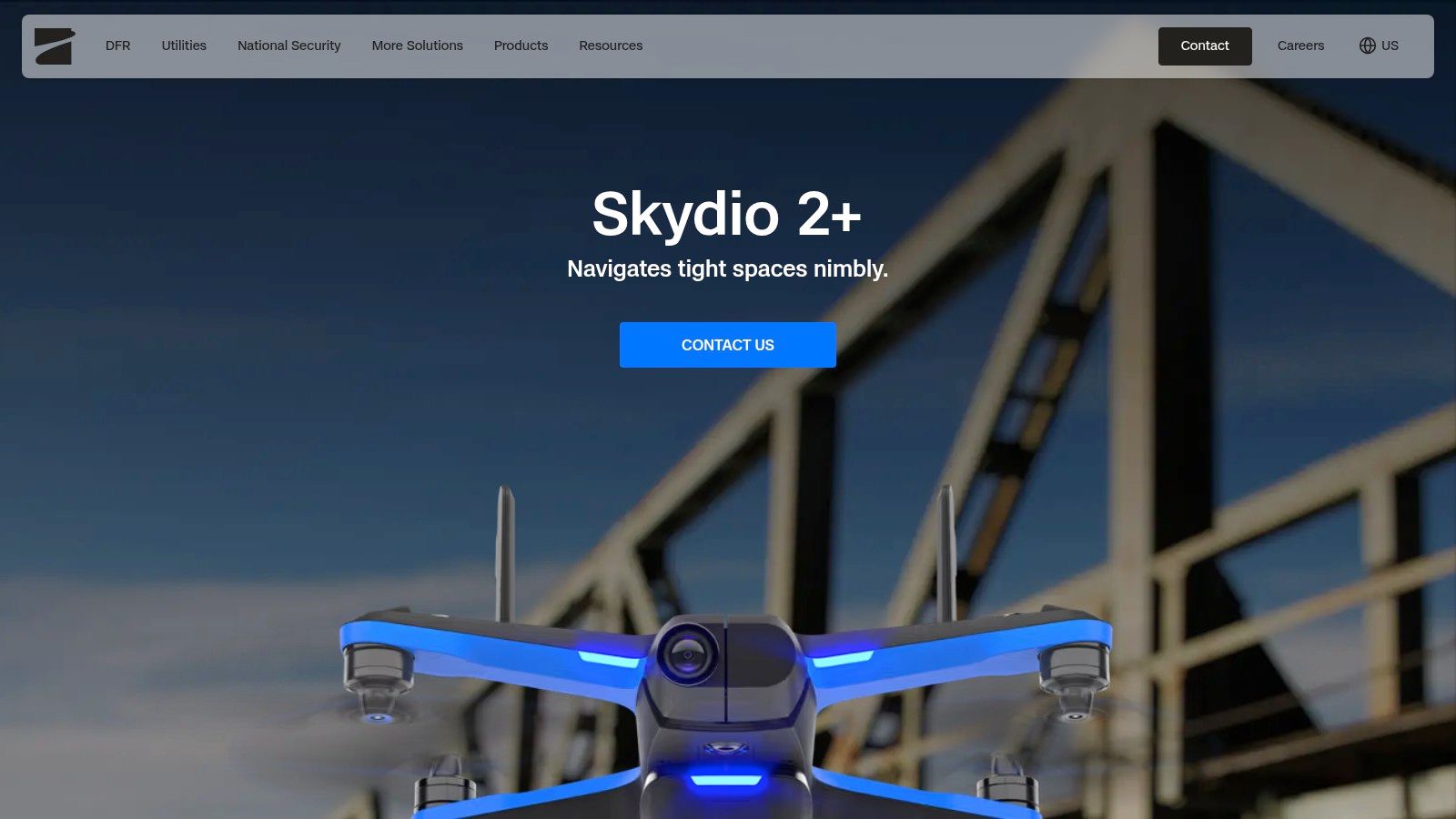
This impressive autonomy is powered by six 4K navigation cameras and sophisticated AI processing. These cameras provide a 360-degree view of the surroundings, enabling the drone to build a real-time 3D map of its environment and react to obstacles in milliseconds. For capturing footage, the Skydio 2+ utilizes a separate 4K60 HDR camera with a 1/2.3" CMOS sensor. While the camera quality might not match some similarly priced competitors focusing on cinematography, the footage is still impressive, especially considering the challenging environments this drone is designed to handle. It boasts up to 27 minutes of flight time on a single charge and an improved wireless range compared to its predecessor, offering more flexibility for your aerial adventures.
The Skydio 2+ is a compelling option for anyone prioritizing ease of use and autonomous flight. Its intuitive app interface makes setup and operation a breeze, even for novice pilots. The “follow me” and subject tracking features are best-in-class, making it a game-changer for action sports enthusiasts and anyone who wants to capture dynamic footage without the need for a dedicated pilot. The domestic production also appeals to security-conscious users. However, the higher price point (starting at $999) and shorter flight time compared to some competitors are important considerations. Additionally, professional cinematographers might find the limited manual control options restrictive. If you're looking for a drone primarily for capturing cinematic shots with precise manual control, other options might be better suited. However, if autonomous flight and obstacle avoidance are your priorities, the Skydio 2+ is unmatched when you compare drones.
Learn more about Skydio 2+ which discusses Skydio's innovative approach and its applications in various fields. While this article focuses on the Skydio X10, it provides valuable insights into the company's overall philosophy and technological advancements, which are also reflected in the Skydio 2+. The Skydio 2+ deserves its place on this list because it represents a significant step forward in autonomous drone technology, offering a user-friendly and incredibly capable platform for capturing dynamic, hands-free aerial footage. You can find more details and purchase the Skydio 2+ on their website: https://www.skydio.com/skydio-2-plus.
5. DJI Air 3
When you compare drones, the DJI Air 3 stands out as a compelling mid-range option bridging the gap between consumer-friendly features and professional-grade capabilities. This makes it ideal for serious hobbyists, aspiring content creators, and even some commercial applications. Its dual-camera system, featuring both a wide-angle and a 3x medium telephoto lens, both with 1/1.3-inch CMOS sensors, opens up creative possibilities previously unavailable in this price range. Imagine capturing sweeping landscapes with the wide lens and then seamlessly switching to the telephoto for a close-up of distant wildlife, all in stunning 4K/60fps quality with a 10-bit D-Log M color profile for maximum post-production flexibility.
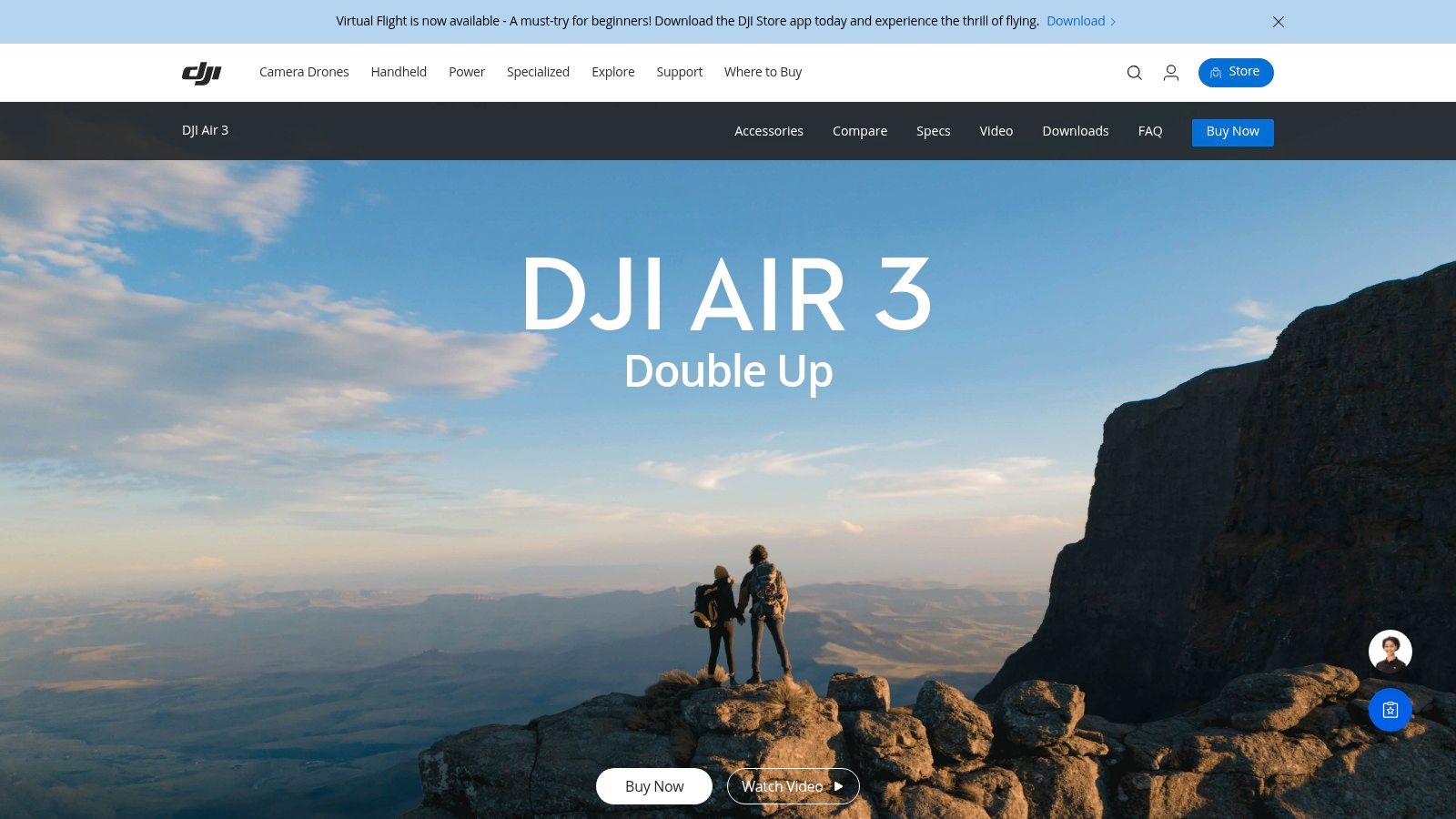
The Air 3's standout feature is its impressive 46-minute maximum flight time, the longest in DJI's consumer drone lineup. This extended flight time translates to more time capturing footage and less time swapping batteries, a crucial advantage for time-sensitive projects or extended exploration. For those concerned about safety and ease of use, the Air 3 boasts omnidirectional obstacle sensing, making it safer to fly in complex environments. The advanced tracking features allow the drone to follow subjects autonomously, freeing up the pilot to focus on framing the perfect shot. Furthermore, the O4 video transmission technology enables a robust 20km transmission range, ensuring a stable connection even at longer distances.
Comparing the Air 3 with similar models like the DJI Mavic 3 Classic reveals key differences. While the Mavic 3 Classic boasts a larger Four Thirds sensor for superior image quality in low-light conditions, the Air 3 offers greater versatility with its dual-camera system and a significantly more affordable price point, starting at $1,099. This makes it a more accessible option for users who prioritize flexibility and value.
Setting up the Air 3 is straightforward, thanks to DJI's user-friendly Fly app. Simply charge the batteries, connect your smartphone to the controller, and follow the on-screen prompts. While the 8GB of internal storage is limited, it's easily supplemented with an SD card, ensuring ample space for capturing high-quality footage.
Pros:
Exceptional flight time (46 minutes)
Versatile dual-camera system (wide and 3x telephoto)
Compact foldable design
Good value for the feature set (starting at $1,099)
Cons:
No adjustable aperture
Smaller sensors than professional models (like the Mavic 3 series)
No side obstacle sensors in certain tracking modes
Limited internal storage (8GB)
If you're comparing drones and looking for a balance of performance, features, portability, and price, the DJI Air 3 deserves a serious look. Its impressive flight time, versatile dual-camera system, and advanced features make it an excellent choice for a wide range of users, from hobbyists to semi-professionals. Visit the DJI website for more information.
6. Holy Stone HS720E
When you compare drones, especially in the budget-friendly category, the Holy Stone HS720E often stands out. This drone offers a compelling blend of features and affordability, making it an attractive option for beginners and casual users looking to enter the world of aerial photography and videography. It packs a 4K EIS (Electronic Image Stabilization) camera, GPS functionality for stable flight and return-to-home safety, and a respectable flight time of up to 23 minutes. Intelligent flight modes like Follow Me, Orbit mode, and waypoint navigation add to its versatility, allowing users to capture dynamic and creative shots with ease. Its foldable design and included carrying case make it highly portable, perfect for taking on adventures.
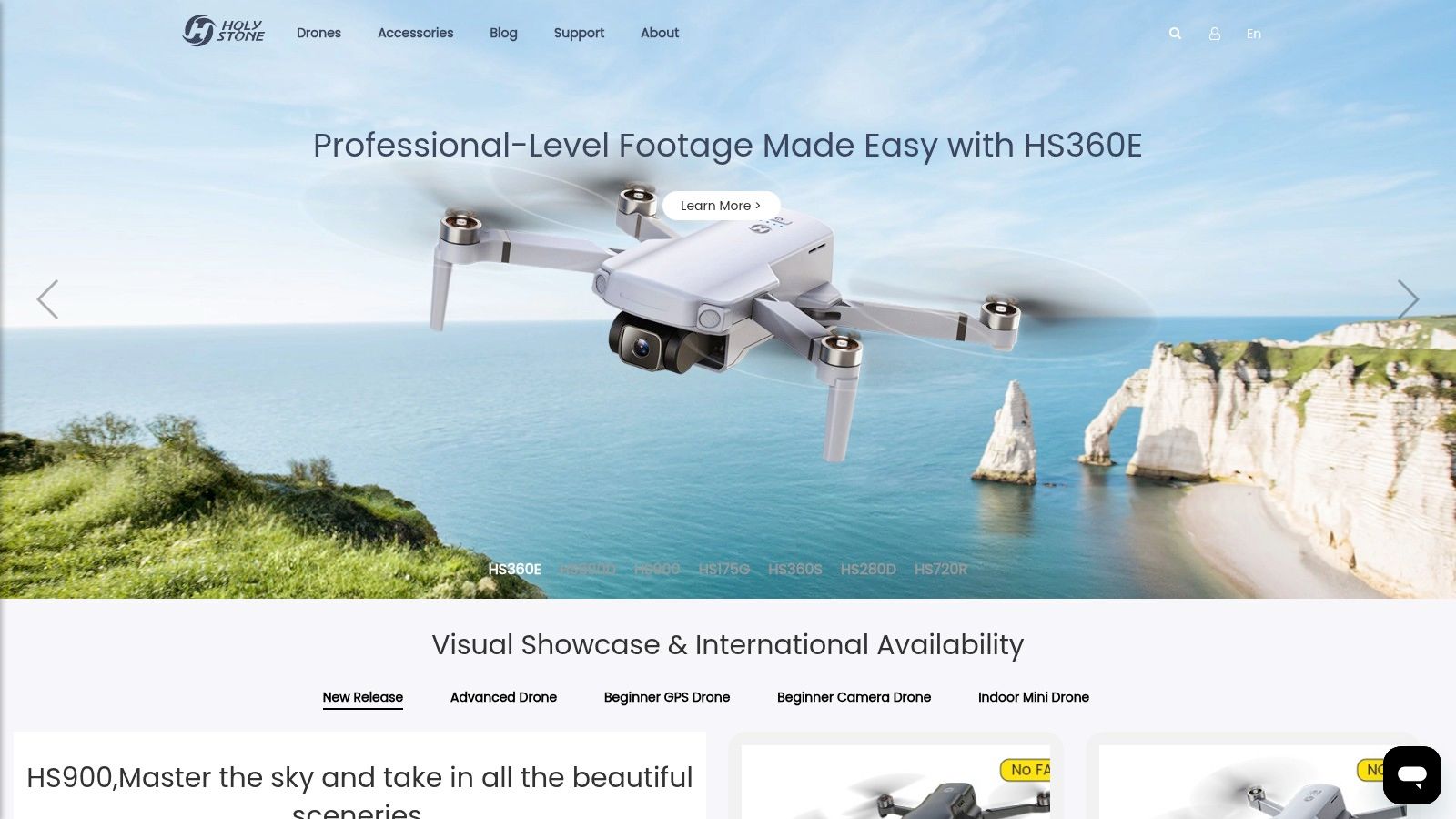
The HS720E shines in its value proposition, often priced under $300. This makes it a significantly more accessible option compared to premium drones from DJI or Autel. While its image quality isn't on par with those higher-end models, it's surprisingly decent for the price, delivering usable footage for social media, personal projects, or simply enjoying the aerial perspective. The 5GHz transmission system ensures a stable connection between the drone and controller for a range of up to 1km, allowing for a wider exploration radius.
For beginners, the HS720E offers a user-friendly experience. The controls are intuitive, and the intelligent flight modes simplify complex maneuvers. This makes it a great platform for learning the ropes of drone piloting before investing in a more advanced model. Learn more about Holy Stone HS720E to ensure a safe and successful flight experience. Before your first flight, familiarizing yourself with a drone preflight checklist is highly recommended for a safe and enjoyable experience.
However, it's important to acknowledge the trade-offs that come with the HS720E's budget-friendly price. While the camera boasts 4K resolution, the image quality and dynamic range are noticeably inferior to premium models. Obstacle avoidance is less reliable, and the drone's wind resistance is also weaker compared to higher-end models. The flight time, while respectable, is also shorter than what you'd get with more expensive drones.
Features:
4K camera with electronic image stabilization
GPS positioning and return-to-home
Up to 23 minutes of flight time
1km control range
Intelligent flight modes including Follow Me and Orbit
Pros:
Excellent value for money (typically under $300)
User-friendly for beginners
Decent camera quality for the price
Comprehensive feature set compared to other budget drones
Cons:
Image quality noticeably inferior to premium models
Less reliable obstacle avoidance
Shorter flight time than premium drones
Less wind resistance than higher-end models
In conclusion, when you compare drones, the Holy Stone HS720E emerges as a strong contender in the budget segment. It provides an excellent entry point for aspiring drone pilots and casual users who prioritize value and ease of use. While it doesn't match the performance of premium models, the HS720E offers a commendable set of features and capabilities for its price, making it a worthwhile option for those seeking affordable aerial exploration.
7. Ryze Tello
When you compare drones, especially for beginners or educational purposes, the Ryze Tello frequently rises to the top. This mini drone, developed in partnership with DJI, punches well above its weight (which is only 80 grams!) and its price point (typically around $99). It's designed as an accessible entry point into the world of drones, offering a surprising number of features without breaking the bank. This makes it ideal for anyone looking to grasp the fundamentals of drone flight before investing in a more advanced model. Whether you're a hobbyist looking for a fun, inexpensive flyer or an educator introducing students to STEM concepts, the Tello offers a compelling package.
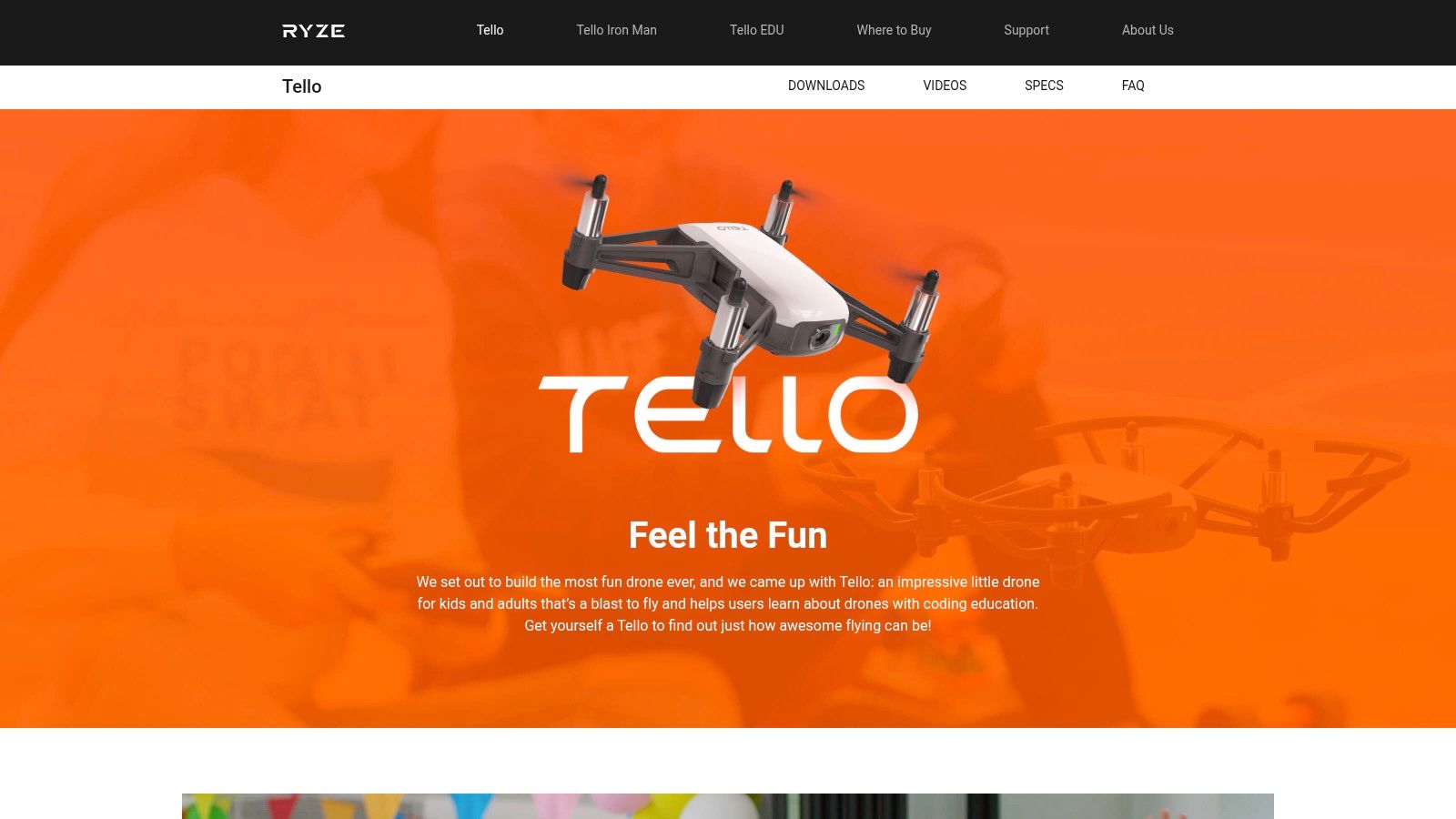
The Tello boasts features typically found on more expensive drones. It captures 720p video with electronic image stabilization, mitigating shaky footage. Its vision positioning system allows for stable indoor flight without GPS, making it perfect for practicing in smaller spaces. Furthermore, its programmability via Scratch and Swift opens up a world of creative coding possibilities, making it a valuable tool for STEM education. Students can learn the basics of programming by controlling the drone's flight path and maneuvers. With up to 13 minutes of flight time on a single charge, the Tello provides ample opportunity to explore these features.
For those comparing drones for aerial photography or videography, it's important to note that the Tello's camera, while capable, is basic compared to professional-grade drones. The 5MP camera and 720p video resolution are suitable for casual use and learning, but won't satisfy the demands of serious content creators. Similarly, its limited range of 100m and lack of GPS make it unsuitable for expansive aerial explorations. The Tello is also highly susceptible to wind, requiring calm conditions for optimal flight.
Despite these limitations, the Tello’s affordability and ease of use make it a fantastic starting point. It’s an excellent choice for anyone wanting to understand basic drone operation and maneuvers. Setting up the Tello is straightforward, requiring only a compatible smartphone and the Tello app. The app provides a user-friendly interface for controlling the drone and accessing its various features, including automated flight maneuvers like flips and bounces. The Tello also offers a great introduction to First Person View (FPV) flight.
Pros:
Very affordable (typically around $99)
Excellent for learning drone basics
Programmable for STEM education
Extremely portable
Cons:
Limited range (100m max)
Basic camera quality
No GPS functionality
Highly susceptible to wind
Website: https://www.ryzerobotics.com/tello
If you're comparing drones and looking for an inexpensive, easy-to-fly, and educational tool, the Ryze Tello deserves serious consideration. It’s a fantastic gateway into the exciting world of drones.
8. PowerVision PowerEgg X
When you compare drones, the PowerVision PowerEgg X stands out for its unique 3-in-1 versatility. It's not just a drone; it's also a handheld camera and an AI camera, making it a compelling option for a variety of users, from hobbyists to professionals. This adaptability earns it a spot on our list, offering capabilities that surpass traditional drones.
Imagine capturing stunning aerial footage of a kayaking trip, then seamlessly transitioning to handheld mode to film the action on the shore. With the PowerEgg X, this is a reality. Its modular design allows you to quickly switch between drone, handheld, and AI camera modes, expanding your creative possibilities. This multi-functionality makes it ideal for vloggers, filmmakers, and anyone who needs a versatile camera system.
The PowerEgg X boasts a 4K/60fps camera mounted on a 3-axis gimbal, ensuring smooth and stable footage even in challenging conditions. Its SyncVoice technology allows for clear audio recording during flight, a feature particularly useful for interviews or capturing ambient sounds. Furthermore, facial recognition tracking enables the drone to follow subjects autonomously, freeing up your hands to focus on other aspects of your shoot. These features make the PowerEgg X a powerful tool for anyone looking to elevate their video content.
One of the PowerEgg X's most impressive features is its optional waterproof capability. While the drone itself isn't inherently waterproof, dedicated accessories allow it to take off and land on water and even fly in rainy conditions. This opens up exciting opportunities for capturing unique perspectives and footage that would be impossible with standard drones. However, it's important to note that these waterproof accessories are sold separately.
While comparing drones, it's important to consider both the pros and cons. The PowerEgg X's versatility and unique capabilities are undeniable advantages. It offers good camera quality and an innovative design. However, it is bulkier than comparable foldable drones, and the app experience isn't as refined as some market leaders. Additionally, its wind resistance isn't as robust as some competitors, so flying in breezy conditions might be challenging.
Pros:
Unique versatility as a multi-function device
Can fly in rain and land on water (with accessories)
Good camera quality (4K/60fps, 3-axis gimbal)
Innovative design and functionality
SyncVoice technology for improved audio
Cons:
Bulkier than comparable drones when folded
Waterproof accessories sold separately
App experience could be improved
Less wind resistant than some competitors
(Pricing information was not readily available at the time of writing. Check the manufacturer's website for current pricing and availability.)
Implementation Tip: Before your first flight, be sure to thoroughly read the user manual and familiarize yourself with the controls and app interface. Practice flying in a safe, open area away from obstacles. If you plan to use the waterproof features, ensure you have the necessary accessories and understand their proper installation and usage.
For more information and to purchase the PowerVision PowerEgg X, visit https://www.powervision.me/en/product/poweregg-x.
The PowerEgg X offers a distinct approach to aerial photography and videography. If you're looking for a versatile tool that goes beyond the capabilities of a standard drone, and are willing to invest in the necessary accessories, the PowerEgg X is definitely worth considering when you compare drones.
Drone Model Feature Comparison
Choosing Your Perfect Drone
Comparing drones can feel like navigating a complex airspace, especially with the diverse range of options available, from the nimble DJI Mini 4 Pro to the powerhouse DJI Mavic 3 Pro. This article has provided a starting point by examining key models like the Autel Robotics EVO Lite+, Skydio 2+, DJI Air 3, Holy Stone HS720E, Ryze Tello, and the unique PowerVision PowerEgg X. The most important takeaway is to align your drone choice with your specific goals. Are you a beginner looking for an easy-to-fly model like the Ryze Tello? Or a professional photographer demanding the cinematic capabilities of the DJI Mavic 3 Pro? If you are looking for drones for professional use-cases, you might want to check out some of the best commercial drone available on the market. Consider factors such as flight time, camera quality, range, portability, and of course, budget, when making your decision.
Implementing your chosen drone effectively also requires planning. Familiarize yourself with local drone regulations, practice safe flying habits, and explore the full potential of your drone's features. Whether you're capturing breathtaking landscapes, inspecting infrastructure, or simply enjoying the thrill of flight, understanding your drone inside and out will elevate your experience.
The perfect drone isn't a one-size-fits-all solution; it's the one that perfectly fits your needs. Ready to delve deeper into the world of drones and find your ideal match? JAB Drone offers comprehensive reviews and comparisons to simplify your search and help you confidently compare drones. Start exploring today and discover the drone that will take your aerial adventures to the next level.




Comments